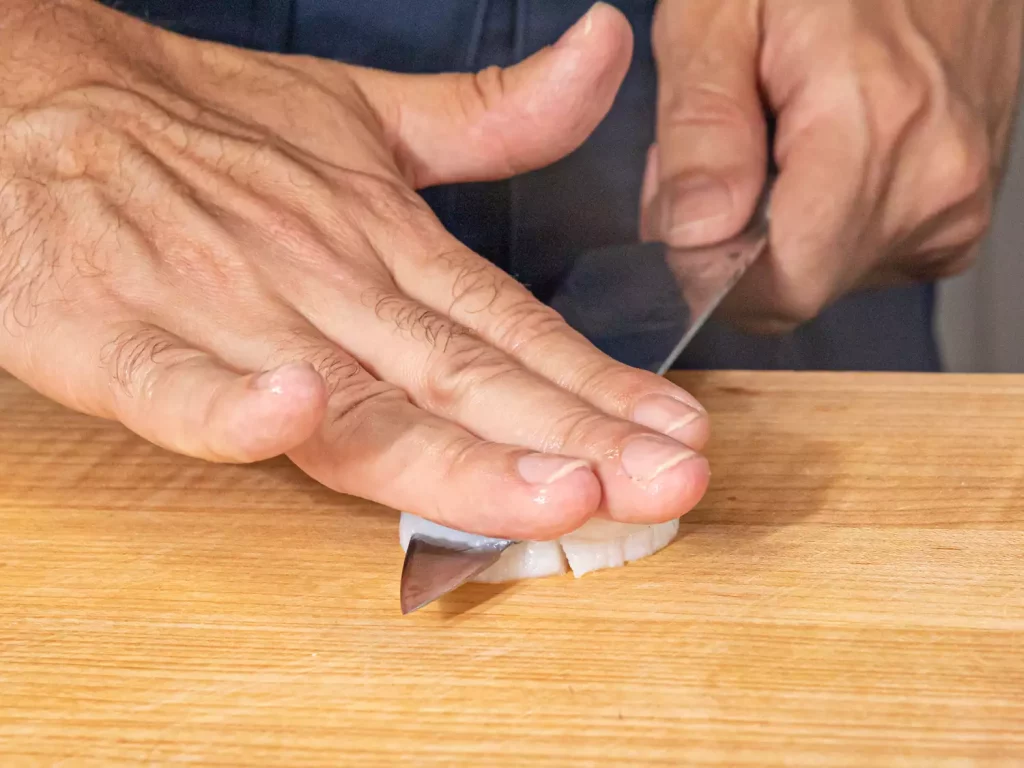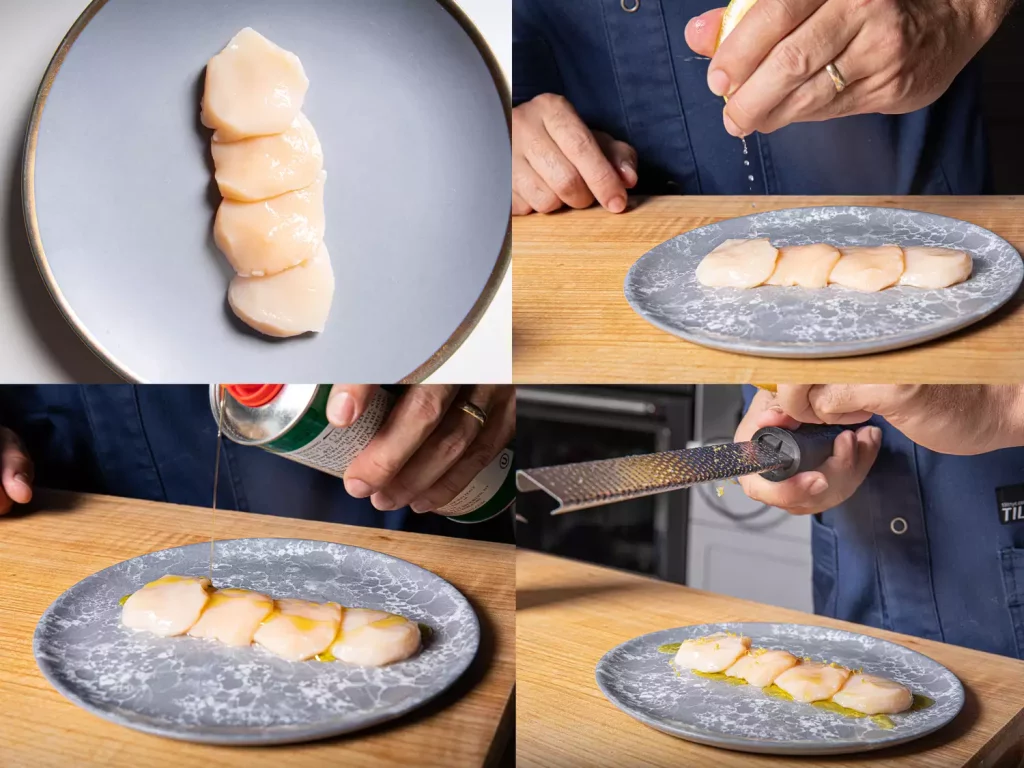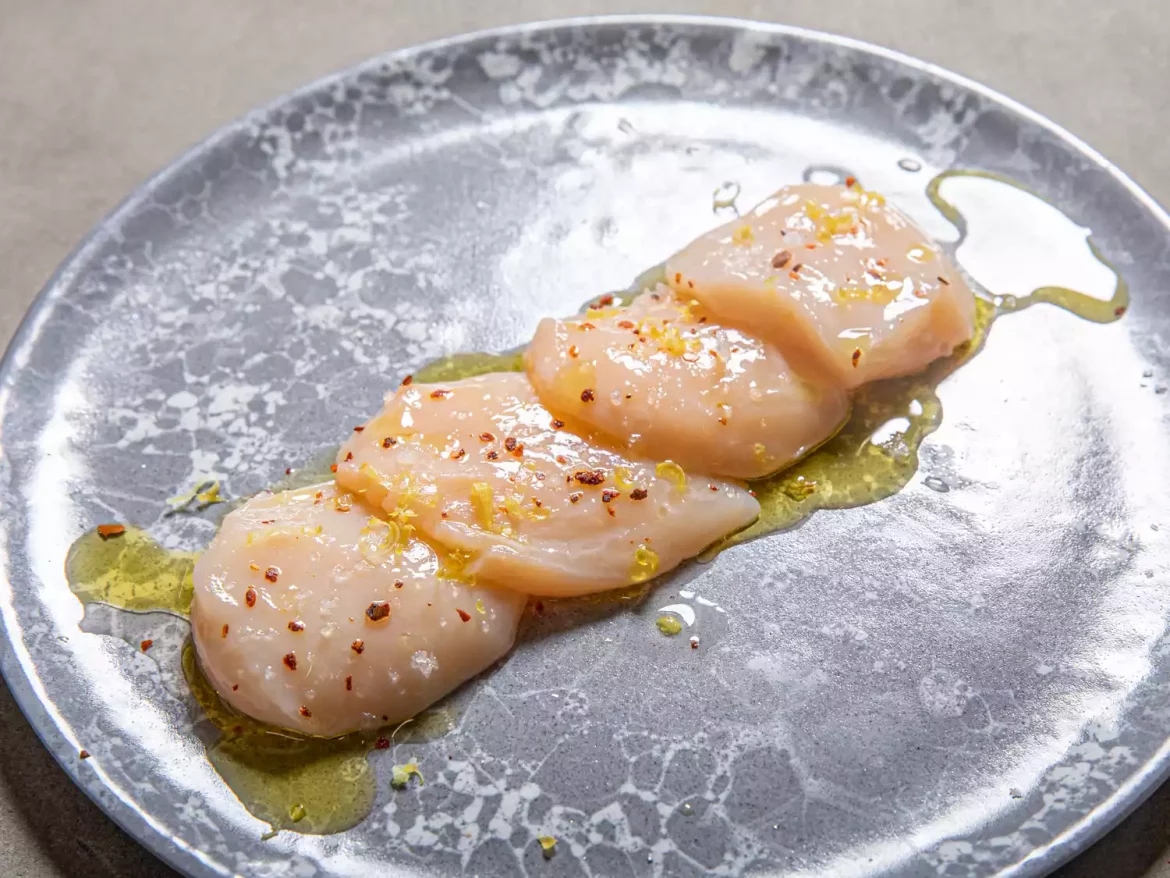Scallop Crudo is a refined and sophisticated dish that highlights the delicate flavors and textures of raw scallops. Originating from Italian cuisine, Crudo is akin to the Japanese sashimi but with a focus on fresh, high-quality seafood and simple, elegant presentation. This comprehensive guide explores the nuances of preparing Scallop Crudo, from selecting the best scallops to mastering the art of plating. Whether you’re hosting a special dinner or simply looking to elevate your culinary skills, this guide will help you achieve the ultimate Scallop Crudo experience.
Cultural Background and Origins
1. Historical Roots
Crudo, meaning “raw” in Italian, refers to dishes prepared with raw fish or seafood, often seasoned with minimal ingredients to let the quality of the main ingredient shine. The concept of serving raw seafood can be traced back to various culinary traditions, including Japanese sashimi and Mediterranean seafood preparations. In Italy, Crudo has evolved into a celebrated dish that emphasizes the freshness and natural flavor of the seafood.
2. Evolution of the Dish
Scallop Crudo, in particular, has gained popularity due to its elegant presentation and the luxurious texture of scallops. While the dish’s roots are in Italian cuisine, it has become a staple in modern fine dining and seafood restaurants worldwide. The preparation of scallops in Crudo form reflects a growing trend towards raw and minimally processed foods in contemporary culinary practices.
Selecting and Preparing Scallops
1. Choosing Fresh Scallops
- Type of Scallops: Scallops are typically sold as either “dry” or “wet.” Dry scallops are preferable for Crudo as they have not been treated with phosphates, which can affect texture and flavor. Look for sea scallops, which are larger and more flavorful than bay scallops.
- Freshness: Freshness is paramount. Choose scallops that have a sweet, ocean-like smell and a firm, translucent appearance. Avoid scallops with a strong fishy odor or a slimy texture, which indicate spoilage.
2. Preparing Scallops for Crudo
- Cleaning: Rinse the scallops under cold water and pat them dry with paper towels. Remove any tough muscle tissues if present, as these can be chewy.
- Slicing: Using a sharp knife, slice the scallops into thin rounds or small pieces, depending on your presentation preference. Aim for uniform slices to ensure consistent texture and appearance.
Ingredients for Scallop Crudo
1. Essential Ingredients
- Scallops: The star ingredient, preferably dry sea scallops.
- Citrus Juice: Lemon or lime juice adds brightness and acidity, which complements the sweet flavor of the scallops.
- Olive Oil: Extra-virgin olive oil provides richness and enhances the natural flavors of the scallops.
- Salt: Sea salt or flaky salt adds seasoning and helps to balance the flavors.
- Fresh Herbs: Herbs such as dill, chervil, or basil can add a fresh, aromatic element to the dish.
2. Optional Ingredients
- Acidic Enhancements: Additional citrus or vinegar (such as sherry or white wine vinegar) can be used to vary the acidity and flavor profile.
- Additional Toppings: Finely sliced radishes, microgreens, or edible flowers can add visual appeal and textural contrast.
- Seasonings: Freshly ground black pepper, red pepper flakes, or flavored salts can enhance the dish’s complexity.

Preparing the Crudo
1. Marinating the Scallops
- Simple Marinade: In a bowl, gently toss the scallop slices with a small amount of olive oil and citrus juice. The acid will slightly “cook” the scallops, giving them a firmer texture and a subtle change in flavor.
- Marination Time: Allow the scallops to marinate for just a few minutes. Over-marinating can alter the texture and flavor too drastically. The goal is to enhance, not overpower, the natural sweetness of the scallops.
2. Plating the Crudo
- Presentation: Arrange the scallop slices on a chilled plate or platter. For an elegant presentation, overlap the slices slightly or fan them out in a circular pattern.
- Garnishing: Drizzle a small amount of olive oil over the scallops, then add a few drops of citrus juice. Sprinkle with sea salt and freshly ground pepper. Garnish with fresh herbs, radish slices, or microgreens if desired.
3. Serving the Crudo
- Temperature: Serve the Crudo immediately after plating to ensure the scallops remain fresh and chilled. The dish is best enjoyed at a cool temperature to highlight the delicate flavors and textures.
- Accompaniments: Offer crusty bread or crackers on the side for texture. A light white wine or sparkling water pairs well with the dish, enhancing its fresh flavors.
Variations and Enhancements
1. Flavor Variations
- Citrus Variations: Experiment with different citrus fruits, such as grapefruit or yuzu, to alter the flavor profile. Each type of citrus brings its unique acidity and aroma to the dish.
- Herb Variations: Try different fresh herbs like mint, cilantro, or tarragon to add new layers of flavor. Each herb will impart its distinctive taste and aroma.
2. Textural Enhancements
- Crunchy Elements: Add thinly sliced radishes, pickled vegetables, or crispy shallots for added texture and contrast.
- Smooth Elements: Consider incorporating a light, creamy element, such as a dollop of avocado mousse or a drizzle of a herb-infused crema.
3. Accompaniments
- Sauces: Serve with a light sauce or vinaigrette for added flavor. A simple ginger-lime vinaigrette or a citrus-soy sauce can complement the scallops beautifully.
- Salads: Pair with a simple salad of mixed greens, cucumber, and herbs for a refreshing and light accompaniment.

Cultural and Regional Variations
1. Italian Crudo Variations
- Sicilian Crudo: In Sicily, Crudo often features citrus-based marinades and garnishes with local ingredients such as capers and olives.
- Venetian Crudo: In Venice, Crudo may be served with a drizzle of high-quality balsamic vinegar and finely shaved Parmesan cheese.
2. Global Influences
- Japanese-Inspired Crudo: Incorporate elements from Japanese cuisine, such as a light soy sauce or wasabi, for a fusion twist on the classic dish.
- South American Influences: Experiment with ingredients like aji amarillo or cilantro for a South American flair, blending traditional flavors with Crudo.
Tips for Perfecting Scallop Crudo
1. Selecting the Best Scallops
- Quality Over Quantity: Choose high-quality scallops from reputable sources. Freshness is key, so purchase from trusted fishmongers or specialty seafood markets.
2. Handling and Storage
- Proper Handling: Keep scallops chilled and handle them with care to avoid bruising. Store them on ice or in the coldest part of your refrigerator until ready to prepare.
- Timing: Prepare and serve Crudo shortly after slicing to ensure the scallops remain at their freshest and most flavorful.
3. Enhancing Flavors
- Balancing Acidity: Adjust the acidity in the marinade to suit your taste preferences. A balance of citrus and oil enhances the scallops without overpowering them.
- Seasoning: Season sparingly and taste frequently. It’s easier to add more seasoning later than to fix an overly seasoned dish.
Conclusion
Scallop Crudo is a dish that celebrates the natural elegance and delicacy of fresh scallops. By understanding the origins, mastering the preparation techniques, and exploring various flavor and presentation options, you can create a stunning and delicious Crudo that highlights the best of Italian culinary traditions. This dish, with its minimalist approach and emphasis on quality ingredients, offers a sophisticated way to enjoy one of the ocean’s most prized delicacies.
With this comprehensive guide, you are well-equipped to prepare and serve Scallop Crudo like a true culinary expert. Enjoy the process of crafting this elegant dish and impress your guests with its refined flavors and beautiful presentation.
This expanded version provides a thorough exploration of Scallop Crudo, covering its background, detailed preparation steps, variations, and practical tips, offering a complete guide to mastering this sophisticated dish.

